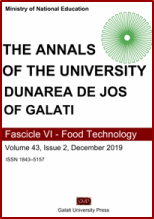Modelling of drying kinetics and comparison of two processes: forced convection drying and microwave drying of celery leaves (Apium graveolens L.)
Abstract
The purpose of this work is to compare two processes: forced convection drying and microwave drying of celery leaves (Apium graveolens L.). This comparison is based on kinetical parameters, moisture diffusivity, variation of the drying rate and energy consumption calculation of both processes. The drying experiments were carried out at different air temperatures (40-120 °C) and at different microwave powers (100-1000 W).Twenty-two empirical models were used to simulate the thinlayer drying kinetics of celery leaves and the best models were selected using three
statistical criteria (R2, χ2 and RMSE). Sledz’s model proved to be the best for celery leaves drying kinetics description with 0.9962 ≤ R2 ≤ 0.9992, 0.000065 ≤ χ2 ≤ 0.000284 and 0.007979 ≤ RMSE ≤ 0.016683 for all the studied temperatures and 0.9971 ≤ R2 ≤ 0.9989, 0.000124 ≤ χ2 ≤ 0.000291 and 0.010910 ≤ RMSE ≤ 0.016914 for all the used powers. Moisture effective diffusivity ranges from 2.22×10-12 to 6.40×10-11 for convective drying and from 1.18×10-11 to 3.13×10-10 m2/s for microwave drying. While in the same order, the activation energies were 36.09 kJ/mol and 77.3 W/g. Regarding the energy consumption, the Specific Electrical Energy Consumption decreased with decreasing temperature or power levels, whereas the opposite was observed with Energy Efficiency. It is clear that many advantages are attributed to microwave drying, including reduced drying time, high drying rate and high moisture diffusivity, low energy consumption and significant drying efficiency, especially when power levels are high.


